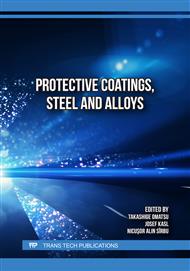p.13
p.23
p.31
p.39
p.45
p.53
p.63
p.69
p.77
Analysis of Stainless Steel 316L Coatings Prepared by High-Speed and Conventional Laser Cladding
Abstract:
This study examines the properties of laser coatings applied to structural steel using 316L stainless steel to enhance corrosion resistance. It compares conventional laser cladding with the Extreme High Speed Laser Cladding (EHSLC) method. Six samples were produced, with Sample 1 using conventional cladding and Samples 2 through 6 using EHSLC with varying parameters. The hardness of the layers varied significantly, with conventional cladding showing the lowest hardness (below 200 HV 0.1) and EHSLC samples reaching up to 600 HV 0.1. These differences are attributed to microstructural variations: austenitic structures had lower hardness and good corrosion resistance is assumed, while martensitic structures exhibited lower chromium and nickel content, leading to different mechanical properties and probably reduced corrosion resistance. The results highlight the importance of parameter selection in EHSLC for optimizing the performance of treated parts.
Info:
Periodical:
Pages:
69-75
Citation:
Online since:
October 2025
Authors:
Keywords:
Price:
Сopyright:
© 2025 Trans Tech Publications Ltd. All Rights Reserved
Share:
Citation:


